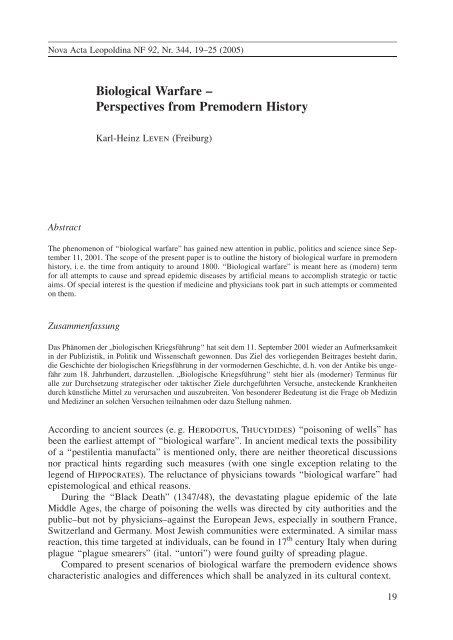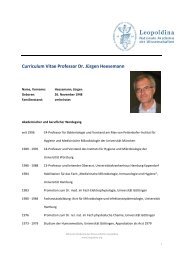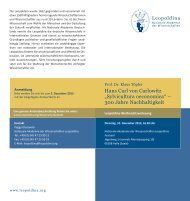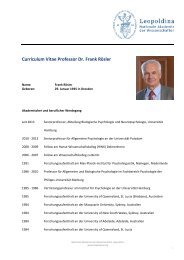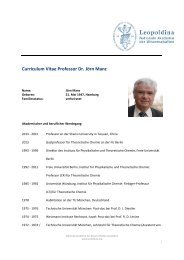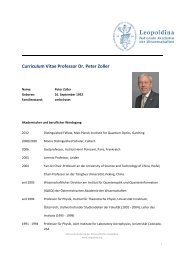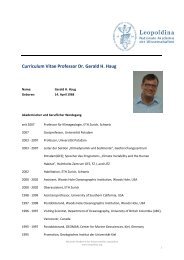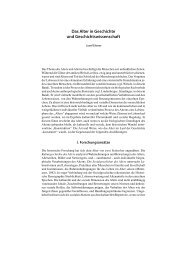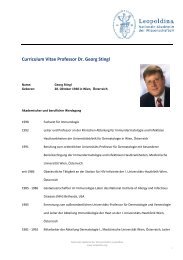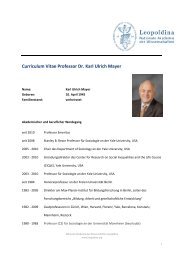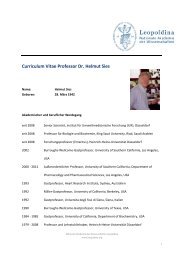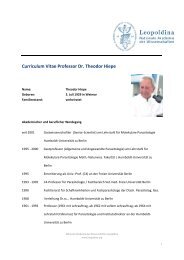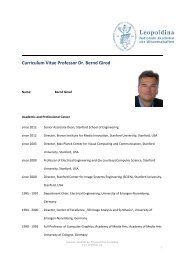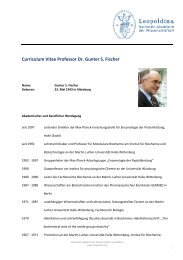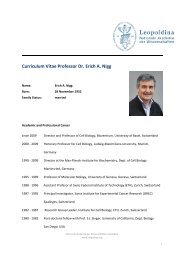Biological Warfare ± Perspectives from Premodern ... - Leopoldina
Biological Warfare ± Perspectives from Premodern ... - Leopoldina
Biological Warfare ± Perspectives from Premodern ... - Leopoldina
Create successful ePaper yourself
Turn your PDF publications into a flip-book with our unique Google optimized e-Paper software.
Nova Acta <strong>Leopoldina</strong> NF 92, Nr. 344, 19<strong>±</strong>25 (2005)<br />
Abstract<br />
<strong>Biological</strong> <strong>Warfare</strong> <strong>±</strong><br />
<strong>Perspectives</strong> <strong>from</strong> <strong>Premodern</strong> History<br />
Karl-Heinz L even (Freiburg)<br />
The phenomenon of ``biological warfareº has gained new attention in public, politics and science since September<br />
11, 2001. The scope of the present paper is to outline the history of biological warfare in premodern<br />
history, i.e. the time <strong>from</strong> antiquity to around 1800. ``<strong>Biological</strong> warfareº is meant here as (modern) term<br />
for all attempts to cause and spread epidemic diseases by artificial means to accomplish strategic or tactic<br />
aims. Ofspecial interest is the question if medicine and physicians took part in such attempts or commented<br />
on them.<br />
Zusammenfassung<br />
DasPhaÈnomen der ¹biologischen KriegsfuÈhrung`` hatseit dem 11. September 2001 wieder anAufmerksamkeit<br />
in der Publizistik, in Politik und Wissenschaft gewonnen. Das Ziel des vorliegenden Beitrages besteht darin,<br />
die Geschichte der biologischen KriegsfuÈhrung in der vormodernen Geschichte, d.h. von der Antike bis ungefaÈhr<br />
zum 18. Jahrhundert, darzustellen. ¹Biologische KriegsfuÈhrung`` steht hier als (moderner) Terminus fuÈr<br />
alle zur Durchsetzung strategischer oder taktischer Ziele durchgefuÈhrten Versuche, ansteckende Krankheiten<br />
durch kuÈnstliche Mittel zu verursachen und auszubreiten. Von besonderer Bedeutung ist die Frage ob Medizin<br />
und Mediziner an solchen Versuchen teilnahmen oder dazu Stellung nahmen.<br />
According to ancient sources (e.g. Herodotus, Thucydides) ``poisoning of wellsº has<br />
been the earliest attempt of``biological warfareº. Inancient medical texts the possibility<br />
of a``pestilentia manufactaº ismentioned only, there are neither theoretical discussions<br />
nor practical hints regarding such measures (with one single exception relating to the<br />
legend of H ippocrates). The reluctance ofphysicians towards ``biological warfareº had<br />
epistemological and ethical reasons.<br />
During the ``Black Deathº (1347/48), the devastating plague epidemic of the late<br />
Middle Ages, the charge ofpoisoning the wells was directed by city authorities and the<br />
public<strong>±</strong>but not by physicians<strong>±</strong>against the European Jews, especially in southern France,<br />
Switzerland and Germany. Most Jewish communities were exterminated. Asimilar mass<br />
reaction, this time targeted at individuals, can be found in 17 th century Italy when during<br />
plague ``plague smearersº (ital. ``untoriº) were found guilty of spreading plague.<br />
Compared to present scenarios of biological warfare the premodern evidence shows<br />
characteristic analogies and differences which shall be analyzed in its cultural context.<br />
19
Karl-Heinz Leven<br />
<strong>Biological</strong> warfare is<strong>±</strong>after the events of September 11, 2001, of new actuality, see letter<br />
to Senator D aschle or some headlines in newspapers. 1<br />
The aim of my paperistolook at historical evidence concerning biologicalwarfare in<br />
premodern times, that means <strong>from</strong> Antiquity to around the year 1800. The term ``biological<br />
warfareº is used here in the sense of generating epidemics by artificial means to<br />
achieve tactical orstrategic aims in war.Inancient sources it is called ``handmade plagueº,<br />
Latin: pestilentia manu facta or with the synonyme ``poisoning ofwellsº.<br />
Especially interesting is the question if medicine ormedical authors in premodern<br />
times were involved in any form ofbiological warfare.<br />
In the following remarks Ishall try to give atypology of instances of biological warfare,<br />
with special regard to the sources which talk about it.<br />
1. Poisoning ofWells as Military Device and Part of Tactics inWar<br />
One of the earliest accounts concerning poisoning the wells can be found in the ``History<br />
of the Peloponnesian Warº, written by the Athenian T hucydides .Aterrible plague<br />
spread at Athens inthe summer of 430 B. C. and he states (Thucydides 2, 48, 2): ``It<br />
struck the city of Athens suddenly. People in Piraeus [harbor] caught it first, and so,<br />
since there were not yet any fountains there, they actually alleged [Greek: elechthe] that<br />
the Peloponnesians [Spartans and allies] had put poison in the wells [Greek: pharmaka<br />
esbeblekoien es ta phreata ].º 2<br />
The short notice ofT hucydides, anancient author held to be absolutely trustworthy,<br />
is apivotal point for our subject insome respects:<br />
( i ) Poisoning the wells is presented as amilitary device tobeat atown under siege.<br />
( ii) Thucydides presents the passage about poisoning the wells not as afact, but as a<br />
rumor, arumor one might add that hehimself certainly did not believe in. This specific<br />
blending of fact and rumor accompanies the history of biological warfare<br />
through the centuries until the present time.<br />
( iii) Finally, Thucydides' account about poisoning the wells has at least asemantic<br />
connection to medicine: we read of pharmaka that are thought to be thrown into<br />
the drinking water. Wehear nothing about the kind of pharmaka used<strong>±</strong>we shall return<br />
to this point.<br />
Poisoning the wells as amilitary device was mentioned for the first time by the Greek<br />
historian H erodotus ,one generation prior to T hucydides. Herodotus (Hdt. 9,49, 2;<br />
Plut. Arist. 16, 8) writes, that the Persians before the decisive battle of Plataea, lost by<br />
them, spoiled the fountain that the Greeks used as drinking water.<br />
Ancient manuals of military tactics mention as substances apt to poison wells carcasses,<br />
excrements, poisonous plants and lime (App. BC2,44; Lucan. 4,318; Nic.<br />
Chon. 179 v. D.). Ageneral facing the danger of poisoned wells should test the water<br />
quality on prisoner of war (Maur. Strat. 9,3,124).<br />
1FAZ: 4. Okt. 2001 ¹Mobilmachen gegen Biowaffenª, 22. 10. 2001 ,,Anthrax-letter to Daschleª,<br />
14. 12. 2002 ,,Apokalyptischer Reiter aus dem KuÈhlschrankª, 21. 2. 2003 ¹Saddams Phantompockenª,<br />
7. 1. 2004 ,,Angriffder Gen-Kriegerª.<br />
2Translation L loyd 2003, p.137.<br />
20 Nova Acta <strong>Leopoldina</strong> NF 92, Nr. 344, 19 <strong>±</strong>25 (2005)
Nowhere ismentioned that physicians should be asked in cases of poisoning the wells. It<br />
seems as ifpoisoning of wells belonged to the basic tactical knowledge of any officer.<br />
The plague that reached Western Europe in 1348, to come toahistorical example of a<br />
kind of biological warfare, had its origin inthe Black Sea: Italian chronicles report the<br />
siege of Caffa, aGenuese town at the peninsula Krim, byTartaric forces. When aplague<br />
broke out, the tartars, who were not able to conquer the town, threw the corpses of their<br />
own men over the walls of Caffa. Genuese ships brought men first to Constantinople and<br />
then to Italian and French sea harbors which were infected with this new devastating<br />
plague (Bergdolt 1994).<br />
It iswell known that European infectious diseases were transferred to the Americas<br />
since the end of the 15 th century. Smallpox and measles devastated Caribbean islands<br />
and the whole continent with the result that the Indian civilization, Aztecs, Incas and<br />
North American, could not resist the small expeditions of Spanish and later English adventurers.<br />
S tannard coined the term ``American Holocaustº for this disease transfer of historical<br />
dimension. But this transfer, although caused byEuropeans,is no example of biological<br />
warfare, because there was nointention to infect America.<br />
This kind of intention can be found some two centuries later, in 1763, on alocal<br />
scene: Sir Jeffery A mherst ,Commander-in-Chief of the British forces in North America,<br />
and Colonel Henry B ouquet, exchanged letters at the time of the Pontiac rebellion.<br />
(Amherst: ``Could it not be contrived tosend smallpox among these disaffected tribes<br />
of Indians? Wemust on this occasion use every strategem in our power to reduce them.º<strong>±</strong><br />
B ouquet: ``I will try to inoculate the [Names oftribes] with some blankets that may fall<br />
in their hands, and take care not to get the disease myself.º) 3<br />
2. Poisoning ofWells and Medical Theory Concerning the Spread ofEpidemics<br />
In ancient medical texts and in non-medical texts too, there are no hints that physicians<br />
took part in poisoning the wells for military aims. Why did physicians with their competence<br />
concerning venom not take part? There are two main reasons, one technical, another<br />
depending on the self-image and social standing of the ancient physician:<br />
( i ) Itwas only theoretically possible to generate an epidemic byartificial means. Ancient<br />
medical theory thought that epidemics were caused by pollution in the air, in<br />
Greek miasmata ,akind of poison, which should arise <strong>from</strong> swamps in hot climate,<br />
or in putrid corpses of men and animals. The individual case of plague was viewed<br />
as putrefaction (in Greek: sepsis )within the living body, and by way ofanalogy<br />
medical theory held putrefaction in the environment responsible for generating the<br />
miasmata of plague. Thus, plague as awhole was akind ofmass-poisoning, the<br />
element poisoned being the air. Ancient physicians never gained aconcrete idea<br />
about the nature of these miasmata. So itwas practically not possible to produce<br />
this poison artificially.<br />
3Mayor 1995, pp.57f.<br />
<strong>Biological</strong> <strong>Warfare</strong><strong>±</strong><strong>Perspectives</strong> <strong>from</strong> <strong>Premodern</strong> History<br />
Nova Acta <strong>Leopoldina</strong> NF 92, Nr. 344, 19 <strong>±</strong>25 (2005) 21
Karl-Heinz Leven<br />
( ii) Now the second reason why physicians did not partake in poisoning of wells. The<br />
social standing of the physician was precarious. His prestige, in Greek doxa ,also<br />
meaning ``fameº, depended on his skills in diagnostics, therapeutics and especially<br />
prognostics, and on trust in his virtue: asthere was nostate regulation of medicine,<br />
no official control of quality whatsoever, and at the same time popular prejudices<br />
against physicians, physicians were anxious to display inpublic the virtue of philanthropy,<br />
in Greek: philanthropia .Physicians partaking in poisoning the wells would<br />
have damaged the fame of the whole profession. The physician G alen of P ergamon,<br />
who lived inthe 2 nd century A. D., court physician ofemperor M arc A urel,<br />
called warfare which tried to poison wells or food a``villainyº (Greek: panourgia ).<br />
(Ther. Pis. 5.K14, 231)<br />
3. Poisoning ofWells and Worldwide Conspiracy: Plague and Persecution<br />
of Jews in the Late Middle Ages<br />
In the course of the Black Death in the 14 th century, the worst catastrophe that Europe<br />
ever encountered inrecorded history, we find the rumor ofpoisoning the wells playing a<br />
fatal role. This rumor rushed ahead ofthe plague, spreading <strong>from</strong> southern France tothe<br />
North.<br />
Popular resentment targeted the Jews, living in communities in the trade cities along<br />
the way inSwitzerland and Germany. The Jews were found guilty of poisoning the<br />
wells<strong>±</strong>before the plague's arrival. Under torture they confessed<strong>±</strong>and most communities<br />
were exterminated, in Freiburg inJanuary 1349, in WuÈrzburg at the end ofApril 1349.<br />
Partly, this was asort of mass hysteria, but the persecution and murder of the Jews<br />
was nospontaneous action, it was planned and directed<strong>±</strong>the motives of the hate were<br />
social, economic and religious. Impartial witnesses of these events, such as the Pope's<br />
personal physician, Guy de C hauliac, acknowledged the crime with dismay. Physicians<br />
were not involved in spreading the rumor or in accusing the Jews. Itwas too obvious<br />
that the Jewish conspiracy against Christians did not exist.<br />
In contrast to examples of military action to poison wells, either practical ortheoretical,<br />
the charge against the Jews had ademonicaspect.They were accused of aworldwide<br />
conspiracy,not alocalaction;sincenew testamentaltimesthe Jewswere regarded asenemies<br />
of the Christians, the fight was between good and evil. The Jews thus were held responsible<br />
because admittedly there were clever and able to take suchaworld-wide action,<br />
but moreover they were regarded to beunited with demons and the devil himself.<br />
But how could such nonsense of murderous dimension gain acceptance? Wehave to<br />
look again at the opinions about the origin ofepidemics:<br />
( i ) The medical theory of the miasmata was neutral, because there was nohuman responsibility.<br />
( ii) Itwas an everyday experience ofmedical laymen that plague was contagious, for<br />
the first time mentioned explicitly by the Athenian T hucydides, the same who<br />
also mentioned the popular rumor of poisoning the wells. Contagion meant and<br />
means that someone is the cause ofanother one's illness. There issomething, asubstance<br />
ofpoisonous kind on men and goods, transmitting the disease.<br />
22 Nova Acta <strong>Leopoldina</strong> NF 92, Nr. 344, 19 <strong>±</strong>25 (2005)
<strong>Biological</strong> <strong>Warfare</strong><strong>±</strong><strong>Perspectives</strong> <strong>from</strong> <strong>Premodern</strong> History<br />
( iii) Finally, athird concept was religious: epidemics are divine punishments for sin and<br />
hybris, of individuals such as David in the Old Testament or Oedipus inGreek<br />
mythology, or Agamemnon in the homeric epic of the Troyan war, or of whole peoples<br />
such as the Philistines in the Old Testament.<br />
This same view istobe found in the Christian religion and was relevant especially in the<br />
Middle Ages.<br />
These three different ways of explaining epidemics created incombination akind of<br />
illegitimate offspring: the idea of poisoning the wells. When God <strong>from</strong> time to time<br />
would send aplague itwas only too natural tobelieve that his adversary, devil himself,<br />
or his creatures, e.g. the hated Jews, would do the same. And how did the devil do this?<br />
He had<strong>±</strong>so tosay<strong>±</strong>studied medicine and used poison. All this was only arumor, but a<br />
rumor with some probability, aprobability which inparts was founded in contemporary<br />
medicine. Wehave seen that academic medicine regarded plague as akind of mass-poisoning.<br />
For people outside medicine itseemed possible that such poisons could be produced<br />
and distributed artificially, in the sense of a pestis manu facta .<br />
4. ``Plague-smearersº and Administration in Early Modern Times<br />
The rumor ofpoisoning the wells stayed active in early modern times. In1630 aterrible<br />
plague struck Milan inItaly. Alessandro M anzoni in his novel ``Ipromessi sposiº, published<br />
in1827, and his ``Storia della colonna infameº, achronicle, has given avivid<br />
picture of it. This time public rumor held ``plague smearersº, Italian: ``untoriº responsible<br />
for distributing the epidemic bysmearing ayellow liquid on walls. The public reacted<br />
in ahysterical manner: any suspicious movements, any suspicious substance, liquids<br />
or powder, visible in public were held to be material ofartificial contagion. There<br />
were several cases of lynching.<br />
The authorities of Milan took two men, one of them member of the city's sanitarian<br />
administration, and by torture extorted their confession that they had worked as untori.<br />
By executing them the authorities tried to calm the public hysteria. Wefind here anew<br />
and important trace inthe history of poisoning the wells: the rumor, formerly directed<br />
against minorities, especially Jews, in early modern Europe turned against the authorities.<br />
Atthe same time that cities tried to fight against plague epidemics by sanitarian<br />
measures, people were suspicious that these authorities in reality tried to spread plague,<br />
especially among the poor. The rumor thus got asocial and political aspect.<br />
Whereas inthe Middle Ages demonic powers were held to be the real cause behind<br />
the pestilentia manu facta ,the rumor now was kind of secularized. Evidence for the<br />
alleged conspiracy ofauthorities was the fact that some epidemics, e.g. Cholera, were<br />
spread especially among the poor. Inthis connection wesee public riots against the<br />
authorities and pharmacies, in the course of cholera epidemics inthe early 19 th century,<br />
<strong>from</strong> St. Petersburg toParis, again including lynching of alleged poisoners.<br />
Nova Acta <strong>Leopoldina</strong> NF 92, Nr. 344, 19 <strong>±</strong>25 (2005) 23
Karl-Heinz Leven<br />
5. Summary and Prospects<br />
The idea of poisoning the wells in Antiquity originally waspart of military tactics. This idea<br />
had some plausibility as medicine itself compared aplague toan air-born mass-poisoning.<br />
The concept of poisoning the wells won its impact inhistory by rumor. Not artificial<br />
plague but the popular believe in it was decisive.<br />
In the Middle Ages, the poisoners ofwells were seen as demonic creatures, inspired<br />
by devil himself. Since the early modern time, the poisoner lost this demonic feature.<br />
The popular rumour now focused on aconspiracy ofhated authorities.<br />
Compared to the present threat ofbiological warfare there are analogies and differences<br />
to the poisoning the wells of premodern times:<br />
( i ) Infectious diseases inscientific medicine are interpreted and conceptualized almost<br />
exclusively by microbiology. The idea to use medical knowledge to prepare a<br />
biological war was born during the First World War and nourished since then,<br />
although in practice never performed. Asitappears, technical and logistical reason<br />
let abstain military men <strong>from</strong> using bacteria or viruses.<br />
( ii) Present popular believe concerning the artificial spread ofinfectious diseases revolves<br />
around the image of secret military laboratories. The present day ``plague<br />
smearerº until recently was seen as an unscrupulous scientist, which under his<br />
white coat wore auniform, especially the uniform of the US-army.<br />
( iii) Since September 11, 2001, the figure of the demonic poisoner of wells, known <strong>from</strong><br />
the Middle Ages, has returned as terrorist, this time aquipped with modern scientific<br />
knowledge. This threat generates atavistic fears of being poisoned, which are hidden<br />
under athin layer ofrationality.<br />
( iv) Weare thus facing two effects: the actual danger of biological weapons in the hands<br />
of men who see themselves acting in an eschatological fight between good and evil,<br />
and the fear generated by this danger in western societies.<br />
Iconclude with an image of the rumour, found so important in the history of biological<br />
warfare:<br />
Rumour, latin ``Famaº, is, asthe Roman poet V ergil put in his Aeneis (4, 173 <strong>±</strong>188),<br />
``faster than any other evil, [...]<br />
she causes large cities to fear,<br />
she sticks to fiction and lies<br />
and at the same time is messenger of truth (Latin: nuntia veri ).º<br />
References<br />
B ergdolt , K.: Der Schwarze Tod in Europa. Die Groûe Pest und das Ende des Mittelalters. MuÈnchen: Beck<br />
1994<br />
L even, K.-H.: Die Geschichte der Infektionskrankheiten. Von der Antike bis ins 20. Jahrhundert. Landsberg<br />
(Lech): ecomed 1997<br />
L even, K.-H.: Schwarzer Tod, Brunnenvergiftung und Judenmord <strong>±</strong>nur ein medizinhistorischer Mythos?<br />
Praxis.Schweizerische RundschaufuÈ rMedizin 89,373<strong>±</strong>381 (2000)<br />
L even, K.-H.: Antike Medizin. Ein Lexikon.MuÈnchen:Beck 2005<br />
L loyd,G.E.R.: In the Grip of Disease.Oxford: Oxford University Press 2003<br />
24 Nova Acta <strong>Leopoldina</strong> NF 92, Nr. 344, 19 <strong>±</strong>25 (2005)
M ayor, A.: The nessus shirt in the New World. Smallpox blankets inhistory and legend. J.Amer. Folklore<br />
108,54<strong>±</strong>77 (1995)<br />
S tannard, D.E.: American Holocaust. Columbus and the Conquest of the New World. New York: Oxford<br />
University Press 1992<br />
Prof. Dr.Karl-Heinz L even<br />
UniversitaÈt Freiburg<br />
Institut fuÈr Geschichte der Medizin<br />
Stefan-Meier-Straûe 26<br />
79104 Freiburg<br />
Germany<br />
Phone: +49 761203 50 35/50 33<br />
Fax: +49 761203 50 39<br />
E-Mail:karl-heinz.leven@igm.uni-freiburg.de<br />
http://www.uni-freiburg.de/igm/indexigm.html<br />
<strong>Biological</strong> <strong>Warfare</strong><strong>±</strong><strong>Perspectives</strong> <strong>from</strong> <strong>Premodern</strong> History<br />
Nova Acta <strong>Leopoldina</strong> NF 92, Nr. 344, 19 <strong>±</strong>25 (2005) 25


